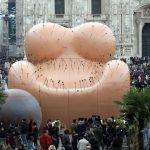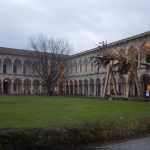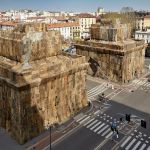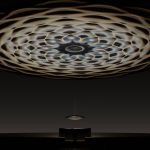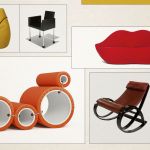
6 art installations for the Milan Design Week
From the Dazi of Porta Venezia reworked by Muhama to the controversial Pesce chair
April 10th, 2019
Design Week has transformed Milan into a sort of open-air museum. Walking through the streets of the city these days means breathing art and enjoying the many installations situated among the various neighborhoods. From Brera to Piazza Duomo, from 5Vie to Porta Venezia the works available are so many that it is difficult to choose which one to visit. nss suggests you 6 that you absolutely must see.
"A friend" by Ibrahim Mahama
Where: Caselli Daziari di Porta Venezia - Piazza Guglielmo Oberdan, Milan 2
The Ghanaian Ibrahim Mahama is the author of the mega installation at Porta Venezia A Friend. Hired by Trussardi Foundation, the artist has wrapped the imposing Caselli Daziari with jute bags, a way to make people think about important issues such as migration, globalization, the movement of goods and people across borders and nations. Jute bags are manufactured in Asia, imported into Africa for transportation on an international scale of various kinds of goods and then torn, patched. These mendings are the symbol of conflicts and dramas that for centuries have been consumed in the shadow of the global economy. Mahama explains that each of them
"tells about the hands that raised it, like the products it brought with it, through ports, warehouses, markets and cities. People's conditions remain imprisoned there. And the same happens to the places it passes through”.
A Friend will remain visible from Tuesday 2 to Sunday 14 April 2019, for more info visit the Trussardi Foundation website.
“Echo Pavilion” by Pezo von Ellrichshausen
Where: Corte d'onore of Palazzo Litta, Corso Magenta 24
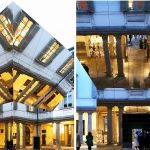
"This object can be understood as a magnifying glass with two opposite effects: the exterior, coated in polished stainless steel, reflects the historical architecture in which it is located, while the interior, with the grid structure of the walls, rich in textures and shadows, it denies the surrounding environment and attracts attention to the open sky. In this way the pavilion oscillates between appearance, reproduction and disappearance".
"Revealed" by Alex Chinneck
Where: Area Quattrocento, Opificio 31, via Tortona 31
For MDW, Alex Chinneck, an artist famous for his surreal interventions on the urban landscape, has used the entire Spazio Quattrocento building inside Opificio 31, in Via Tortona, as a canvas on which to paint a fake facade that, open from a zip (trademark of the talented English), it lets you catch a glimpse of its interior. Crossing the threshold of the building-work there are other zippers that open gaps in the concrete floor and in the stone walls, from which comes a light that constantly changes color. The work of the urban illusionist is visible from 9 to 14 April 2019, for more info you can go to the site www.tortona.rocks.
“Maestà Sofferente” by Gaetano Pesce
Where: Piazza Duomo
For MDW, Gaetano Pesce reworked his famous UP 5&6, an armchair inspired by the body of a woman designed in 1969 for C&B (now B&B). When it was presented for the first time this particular object had two innovative qualities: it was sold vacuum-packed and, more importantly, it was the first Italian design product to have a political and social meaning, it was the emblem of the woman forced to live in the background, anchored and limited by a world ruled by men. In the new version, the armchair becomes a monumental structure of polyurethane foam with fiberglass coating, 8 meters high and pierced by 400 arrows that recall the numerous abuses suffered by women over the centuries. The original spherical footrest is now replaced by a large ball that resembles that once attached to the feet of prisoners, while the six heads of wild beasts emphasize the cruelty of man. The work of Pesce that stands in front of the Duomo is, since it was inaugurated on April 7th, at the center of numerous controversies. The public is, in fact, divided between those who appreciate the provocation of the artist, those who believe that violence against women is too delicate and important to be represented by such a superficial object, and those who think that the armchair spoils the landscape of the square.
"The Forest of the Violins" by Piuarch and Nemo Monti
Where: Courtyard of the University of Milan, Via Festa del Perdono 7
Between the end of October and the beginning of November 2018, a wave of bad weather and a wind that blew to two hundred kilometers per hour destroyed 12 million trees along the entire Alpine arc. Among these, there was also the forest of Paneveggio, in Trentino, also known as the forest of Stradivari, since the famous violin maker was choosing among these spruces the wood to be transformed into his precious violins. Piuarch and Nemo Monti have chosen to pay tribute to this lost natural resource with an installation entitled The Violin Forest. The result is tree trunks with roots suspended in the void supported by a large architectural spruce easel. The structure is the representation of architecture and should recall the capacity of nature itself to speak to humanity. The installation is located until Friday 19 April in the Courtyard of the State University of Milan on the occasion of the Human Spaces event.
“ROBOTL” by Giò Forma
Dove: Piazza XXV Aprile
RoBOTL is an example of how polluting elements can be transformed into something significant with recycling. This about 6 meters high superhero is, in fact, made with recyclable and disposable elements, mainly with plastic bottles (more than 8000 just to make the skin) and materials from the design industry. Alongside the work, we find the RoBOTL RECYCLING STATION, created in collaboration with Precious Plastic, the global community launched in 2013 by Dave Hakkens with the aim of finding solutions to reduce pollution due to plastic. Here you can participate in educational workshops on the mechanisms of recycling and create together the "Robotl Medaillon", gadget keychains for the public that reflect the symbolic pendant of the superhero. The project conceived by the Giò Forma studio together with Timberland is also the occasion to launch a preview of the brand's new footwear ReBOTL collection, which takes its name from the technology used for the upper and whose models each contain 50% recycled PET.
















































